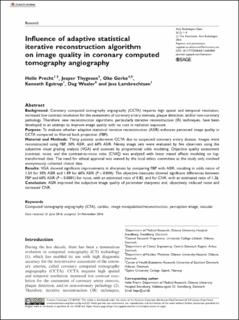| dc.description.abstract | Background
Coronary computed tomography angiography (CCTA) requires high spatial and temporal resolution, increased low contrast resolution for the assessment of coronary artery stenosis, plaque detection, and/or non-coronary pathology. Therefore, new reconstruction algorithms, particularly iterative reconstruction (IR) techniques, have been developed in an attempt to improve image quality with no cost in radiation exposure.
Purpose
To evaluate whether adaptive statistical iterative reconstruction (ASIR) enhances perceived image quality in CCTA compared to filtered back projection (FBP).
Material and Methods
Thirty patients underwent CCTA due to suspected coronary artery disease. Images were reconstructed using FBP, 30% ASIR, and 60% ASIR. Ninety image sets were evaluated by five observers using the subjective visual grading analysis (VGA) and assessed by proportional odds modeling. Objective quality assessment (contrast, noise, and the contrast-to-noise ratio [CNR]) was analyzed with linear mixed effects modeling on log-transformed data. The need for ethical approval was waived by the local ethics committee as the study only involved anonymously collected clinical data.
Results
VGA showed significant improvements in sharpness by comparing FBP with ASIR, resulting in odds ratios of 1.54 for 30% ASIR and 1.89 for 60% ASIR (P = 0.004). The objective measures showed significant differences between FBP and 60% ASIR (P < 0.0001) for noise, with an estimated ratio of 0.82, and for CNR, with an estimated ratio of 1.26.
Conclusion
ASIR improved the subjective image quality of parameter sharpness and, objectively, reduced noise and increased CNR. | en_US |

